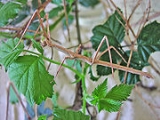
Medauroidea extradentata
Encyclopedia
Medauroidea extradentata, commonly known as the Vietnamese or Annam Walking Stick, is a species of the family Phasmatidae
. They originate in Vietnam
and are commonly found in tropical forests there. They eat a variety of foliage, though in captivity they commonly eat blackberry bramble, hawthorn, oak, red maple and rose.
are a number of small pointed bumps. Their middle set of legs show small flanges and minute spikes. These walking sticks are brownish in color and have six legs, which is a characteristic of all insects. Both male and female Vietnamese walking sticks have no wings.
helps them combat this.
Phasmatidae
Phasmatidae is a family of the stick insects . They belong to the superfamily Anareolatae of suborder Verophasmatodea.Like many of their relatives, Phasmatidae are capable of regenerating limbs and commonly reproduce by parthenogenesis...
. They originate in Vietnam
Vietnam
Vietnam – sometimes spelled Viet Nam , officially the Socialist Republic of Vietnam – is the easternmost country on the Indochina Peninsula in Southeast Asia. It is bordered by China to the north, Laos to the northwest, Cambodia to the southwest, and the South China Sea –...
and are commonly found in tropical forests there. They eat a variety of foliage, though in captivity they commonly eat blackberry bramble, hawthorn, oak, red maple and rose.
Physical Characteristics
Vietnamese walking sticks are approximately 4-5 inches (10–12 cm) in length. Their heads are elongated and oval shaped with thread-like antennae. Their chewing mouthparts are specially adapted for eating plant material. Along its thoraxThorax
The thorax is a division of an animal's body that lies between the head and the abdomen.-In tetrapods:...
are a number of small pointed bumps. Their middle set of legs show small flanges and minute spikes. These walking sticks are brownish in color and have six legs, which is a characteristic of all insects. Both male and female Vietnamese walking sticks have no wings.
Reproduction
Medauroidea extradentata is mainly parthenogenetic, meaning they are asexual, making males very rare in the species. The female drops hundreds of eggs onto the forest floor, these eggs hatch in a few months. The eggs of this species are mottled with black and white and capped with black.Life cycle
The Vietnamese walking stick is short lived, living between 5–7 months. Nymphs look nearly identical to their parents except in size. They molt about 6 times before they become adults. At 3 months of age they become able to reproduce. Their main predators are birds and small mammals, though their camouflageCamouflage
Camouflage is a method of concealment that allows an otherwise visible animal, military vehicle, or other object to remain unnoticed, by blending with its environment. Examples include a leopard's spotted coat, the battledress of a modern soldier and a leaf-mimic butterfly...
helps them combat this.

